Florent Da Silva (178cm/5’10”, 66kg/145.5lbs) turned 19 years old at the beginning of this month. The young midfielder is an academy product of Ligue 1 giants Lyon and already in his young career, he’s attracted plenty of eyeballs, having been described as “one of the club’s biggest talents”.
Da Silva has thus far made just one first-team appearance for Les Gones — a two-minute cameo in a 3-0 win over Strasbourg last season — so would appear to remain some way off starring for the club against the likes of PSG, Marseille and Lille despite earning such plaudits for his talent and rise through Les Gones’ academy. However, in the past, names such as EPL greats Manchester United were said to have been monitoring the teenager’s development, which isn’t a bad sign for the youngster.
With first-team opportunities non-existent for Da Silva in Ligue 1 this term, the teenager made a January loan move to Championnat National 1 side Villefranche until the end of the 2021/22 campaign with the aim of getting some senior football under his belt. Since making that January move that took Da Silva out of his comfort zone and gave him a new challenge, the 19-year-old has been heavily involved for the National 1 promotion contenders, featuring in eight of a possible nine league games, at the time of writing, while delivering some eye-catching performances that may please the decision-makers at his parent club.
This tactical analysis and scout report aims to provide some insight into Da Silva’s game, with a particular focus on his performances on loan at Villefranche this term. This analysis will highlight what I’ve identified as some key strengths and areas of improvement within the teenager’s game and how these traits and skills may best fit specific roles within a team’s overall tactics now and in the future.
Passing
To kick off this tactical analysis, I’m going to focus on Da Silva’s passing ability. The Lyon man has played all around midfield in his young career — in deeper positions and more advanced positions. So far at Villefranche, Da Silva has been primarily used as a left central midfielder, while he’s also been utilised as a right central midfielder at times within his team’s 3-5-2 system. While Da Silva is comfortable operating in a deeper role, I feel that his future ideally lies in a more advanced role, possibly as a ‘number 10’ but definitely in some advanced creative midfielder role.
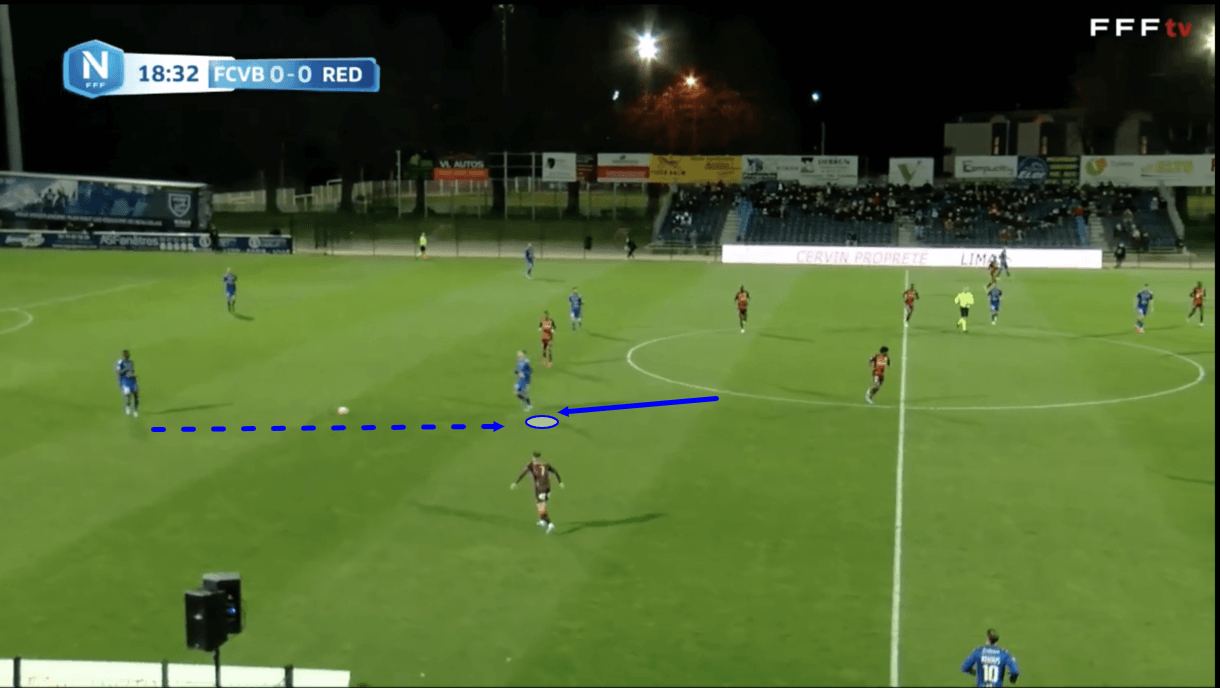
Da Silva has been a useful tool in ball progression for Villefranche, particularly when deployed deeper, as can be seen via the passage of play highlighted in figures 1 and 2. Just before figure 1, we saw the midfielder drop away from his base right central midfielder position to essentially form a temporary double-pivot with the holding midfielder alongside him, which created a 2v1 advantage for Villefranche versus this opposition player, highlighting the intelligence of such movement. The movement from Da Silva was also beneficial for his side because it allowed him to lose his marker, who we see in the opposition’s left central midfield position, having opted not to follow Da Silva as he dropped deep, instead deciding to continue protecting his particular zone of the pitch.
This created a lot of space for Da Silva to receive, turn and decide on his next move without intense pressure from an opposition player forcing him into a rushed decision.
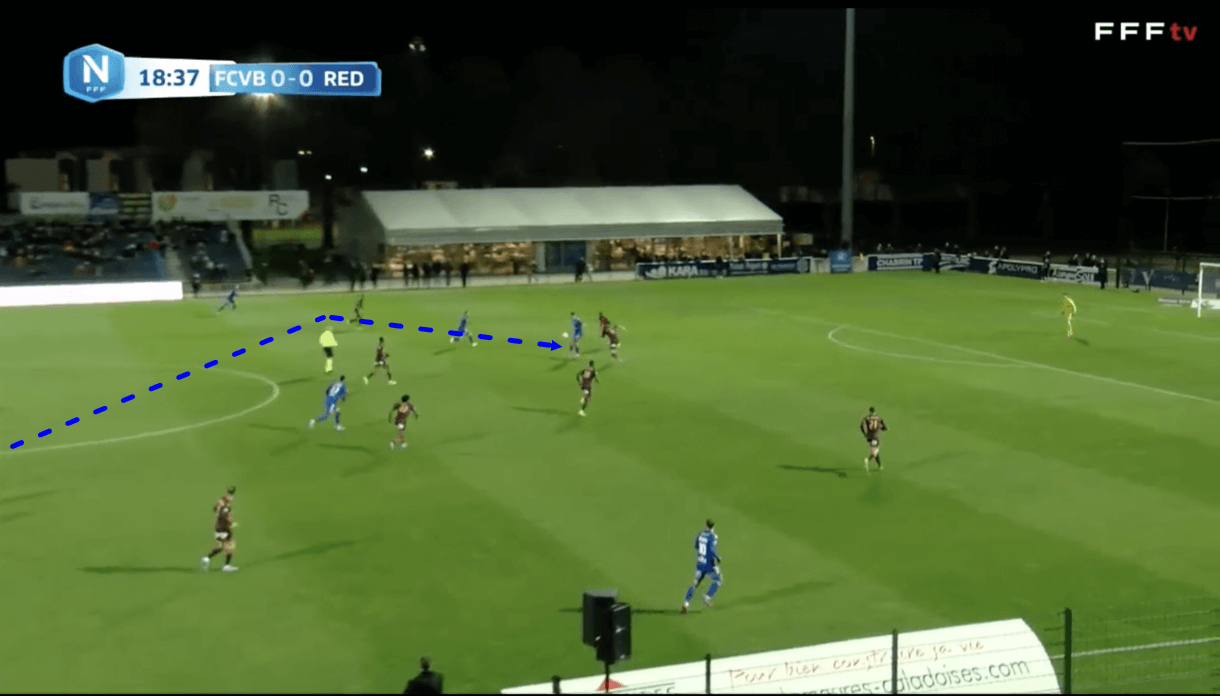
As play moves on into figure 2, we see Da Silva loft a well-weighted and well-placed pass towards his centre-forward, which the attacking teammate greets with a good first touch before sending the ball forward again, playing through a runner next to him who’s moving in behind here.
This just provides one example of how Da Silva’s off-the-ball movement can combine with his vision and technical passing quality to progress his team upfield. Similar to this example, it’s common to see Da Silva try to create from deep via lofted through balls aiming to directly find the runner in behind, which he has done with some success this term. It is worth noting, however, that Da Silva does display some inconsistency with his long passing accuracy and efficiency, so there may still be some room for improvement in this particular area if he is to continue operating in positions like this.
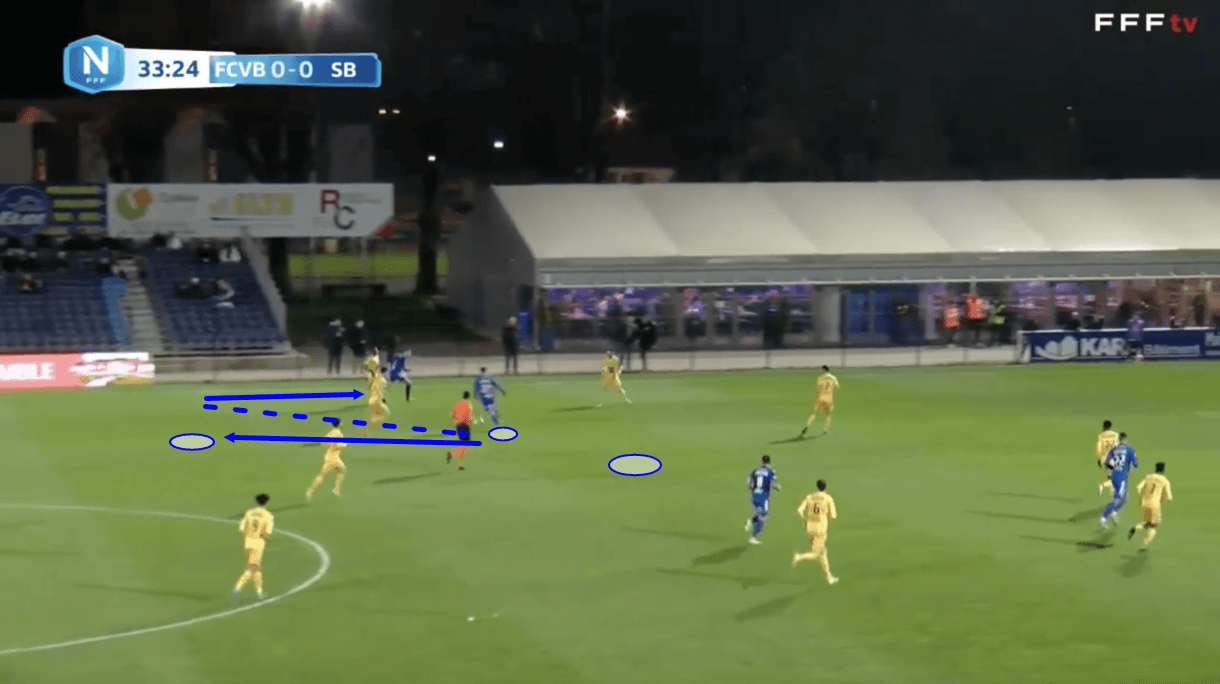
Additionally, at times, as is expected with a young and raw player, Da Silva’s decision-making does let him down, whether it’s with choosing a particular passing option over a better one in a given moment or a scenario like the one we see in figure 3, where he has just received a pass and opted to take a heavy backwards first touch to bring his team into a worse position back behind the opposition’s midfield line rather than receive on the half-turn and drive into the space we can see behind him.
I do see what Da Silva was aiming to do here, and he pulls that off very well. However, I think that rather than taking the ball back behind the opposition’s midfield line to exploit space on the other side, it would’ve been more beneficial for his side to continue driving forward with the ball. This point is made even stronger when we note that although Da Silva relieved pressure from himself and found space in a deeper position, the switch pass opportunity he created was a difficult one to pull off successfully and on playing the long ball across to the right-wing, his long ball was intercepted before reaching the intended target, ending his team’s attack and setting up an opposition counter-attack.
If instead of this, Da Silva had made himself more aware of the space behind him by scanning more and taken the different decision of receiving on the half-turn and exploiting this space we can see behind him, I feel he could’ve directly pushed Villefranche into a far more advantageous position. However, I also feel this would’ve been even better because of Da Silva’s individual quality in more advanced positions.
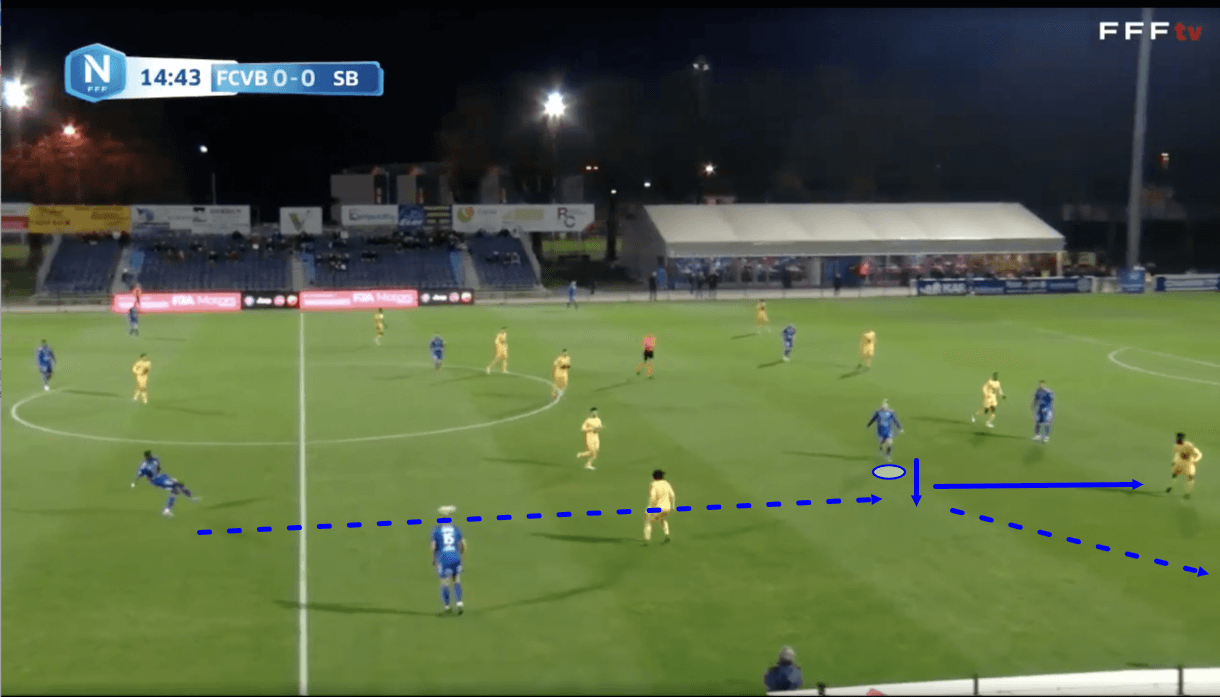
Both in terms of off-the-ball movement and technical passing quality, Da Silva is an excellent asset in advanced areas of the pitch. I think he’s a far greater asset on the receiving end of passes into the final third than he is on the providing side of things, though that’s not to say he can’t be a good ball progressor, because he can and has this term.
Figure 4 shows an example of the creative midfielder shifting from the centre to the right half-space where he can receive a straight progressive pass between four opposition players in a relatively large area. On receiving here, the 19-year-old immediately sends the ball out to his teammate on the right-wing via a short pass to exploit the width and stretch the opposition’s backline. As play moves on from there, we see Da Silva himself exploit the space he and his right-wing teammate have created by charging through the gap between the left-back and left centre-back to receive the right-wing back’s return through ball.
This passage of play highlights the Lyon academy graduate’s tendency to find and exploit space where possible, initially doing so in this example by dropping into the space in front of the backline to receive the progressive pass and relay it to the right-wing back before then turning his attention to being a runner and providing his right-wing teammate with an option exploiting the space in behind the opposition’s backline.
This example is also indicative of the fact that, according to Wyscout, Da Silva has made more deep completions (1.79 per 90) than any other central midfielder to have played at least 600 minutes in National 1 this season.
Da Silva is really good when given this sort of freedom on the pitch to find and exploit space, becoming an option for his teammates in several different areas. He has the mental and technical capabilities to perform this role to a high standard, and I think it’s a role that really suits him and his qualities quite well, so I’d like to see him continue performing a similar role in the future that capitalises on his ability to drift around to find and exploit space.
Off-the-ball movement and ball-carrying ability
The next section of this scout report goes into greater detail on Da Silva’s off-the-ball movement, which we touched on in the previous section, as well as his on-the-ball carrying ability. I do find Da Silva’s passing ability to be more interesting and noteworthy than his ball-carrying ability but both are noteworthy when analysing this midfielder’s game. Meanwhile, I feel his off-the-ball movement and tendency to attack space frequently is such an important part of his game that it’s worth looking at more.
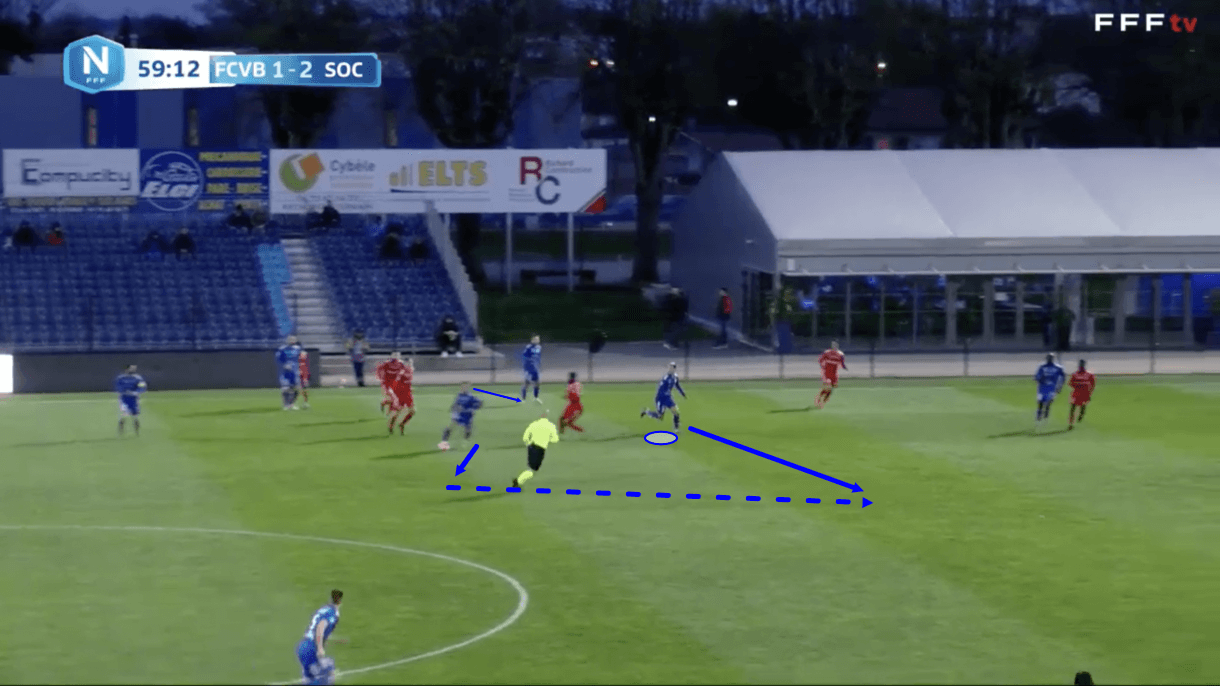
To start with, figures 5-6 look at Da Silva’s off-the-ball movement, with the image above showing an example of the midfielder peeling off the opposition midfielder’s shoulder to attack space centrally, behind the opposition’s midfield line and just in front of their backline. Again, the 19-year-old’s ability to spot space and promptly attack it is a really valuable part of his game, and it’s certainly made him a great asset for Villefranche in the second half of this season.
As play moves on from the image above, we see Villefranche’s deeper midfielder on the ball slide a through pass into the loanee’s path, setting him free through the centre, which is what he was hoping for when making this particular run.
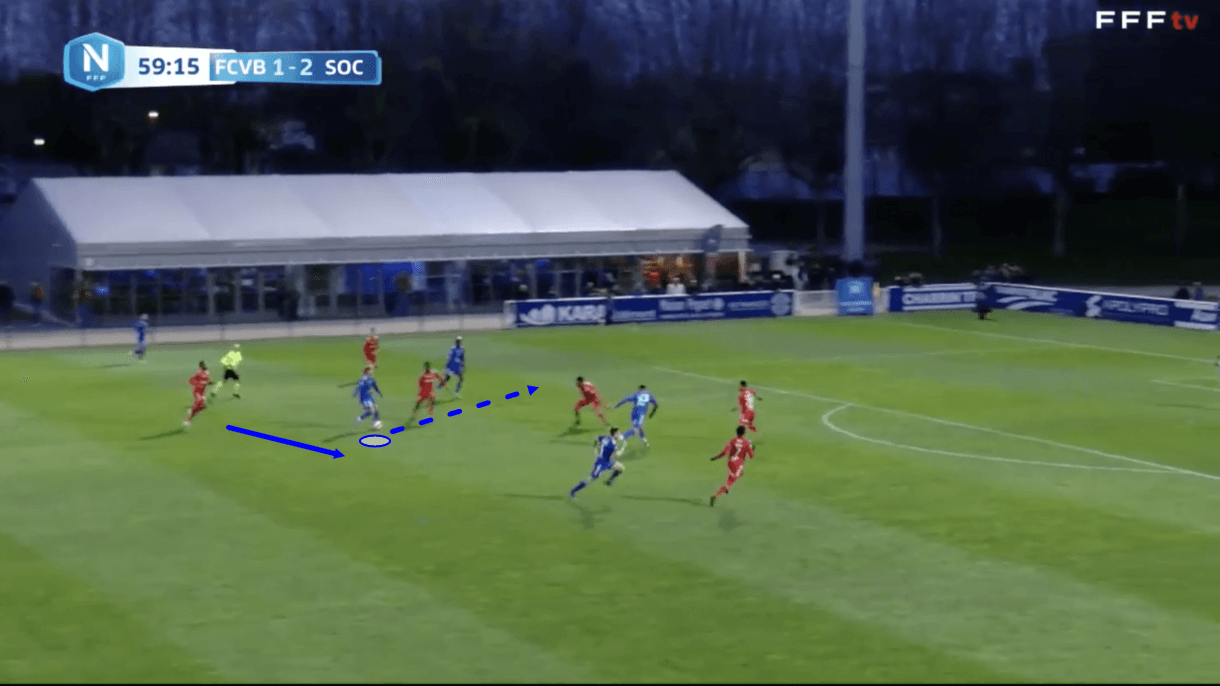
Moving on into figure 6, after receiving this pass from his teammate, Da Silva controlled the ball well, knocking it further forward into his running path towards the centre of the pitch, eventually reaching the opposition’s backline. On doing so, the Villefranche loanee created an opportunity to slide the ball through to a teammate aiming to exploit space behind the opposition’s backline as he dragged an opposition defender out of the backline to leave space for this runner as this defender wanted to confront Da Silva.
As play moved on from the image above, we see Da Silva successfully play his teammate in behind the opposition’s backline with a well-disguised, subtle through pass that the opposition defenders failed to prepare well enough for. Da Silva likes to play disguised passes, which see the passer shape his body and seemingly his focus in one direction, while he’s actually aiming to play his pass in a different direction as we see in figure 6, at times. These types of passes can be very effective because they hide the passer’s intent, and if the player is technically good enough to pull it off, it can create a big advantage for him and his team by making this final ball more difficult to anticipate, and therefore, stop. This is a really useful part of Da Silva’s game that he’s really comfortable with using.
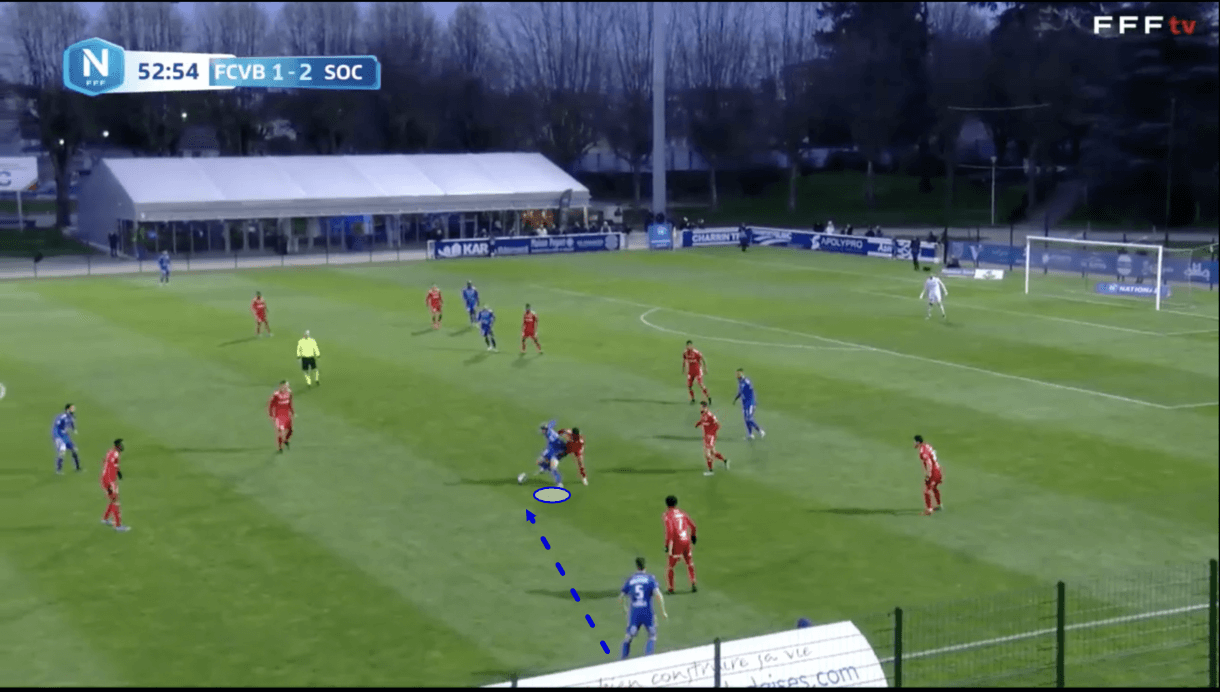
Moving on to discuss ball-carrying ability, Da Silva is very comfortable with picking the ball up when there is space to drive into as we saw in the previous example but he’s also comfortable with operating in tight spaces. I don’t think Da Silva is amazing is 1v1s, you can certainly find better players to get isolated with a full-back out wide, for example, but in tight spaces surrounded by many players, his ability to evade challenges while protecting the ball is excellent while he’s also a great asset when driving forward into open space.
One quality of Da Silva’s that makes him so effective in tight spaces is his ability to use his body to protect the ball from opposition challenges. We see an example of this in figure 7, where the midfielder has just received a pass on the edge of the final third with an opposition player on his back.
Da Silva isn’t the most physically dominant player in the world by any means but he’s not too small either and he likes to get physical. The midfielder is well able to use his body to protect the ball from opposing players as we see here, where we see him getting his hips low, widening his stance and backing into the challenger to keep him away from the ball. This is an excellent stance to protect possession as the low hips and wide stance provide Da Silva with a very solid foundation underneath him while his comfortability with getting physical with the defender and using his body to repel him from the ball also helped him to protect the ball here.
We see Da Silva naturally using these ball protection tactics and similar ones to these quite often when aiming to protect the ball from the opposition in tight spaces. These methods can be useful in such situations because Da Silva can’t afford to knock the ball far from his body and he needs to rely on his close control to keep the ball from getting too close to the opposition surrounding him. As a result, it makes sense to do what he can to knock the opposition away while keeping the ball under control, close to his body.
In addition to this, Da Silva can be seen making light, subtle touches to knock the ball away from opposition challenges in tight spaces. This, again, can be very helpful in protecting possession and evading opposition challenges — you don’t need big heavy touches in such situations as those would take control away from the carrier — instead, light touches are what’s needed and Da Silva is capable of pulling these off masterfully.
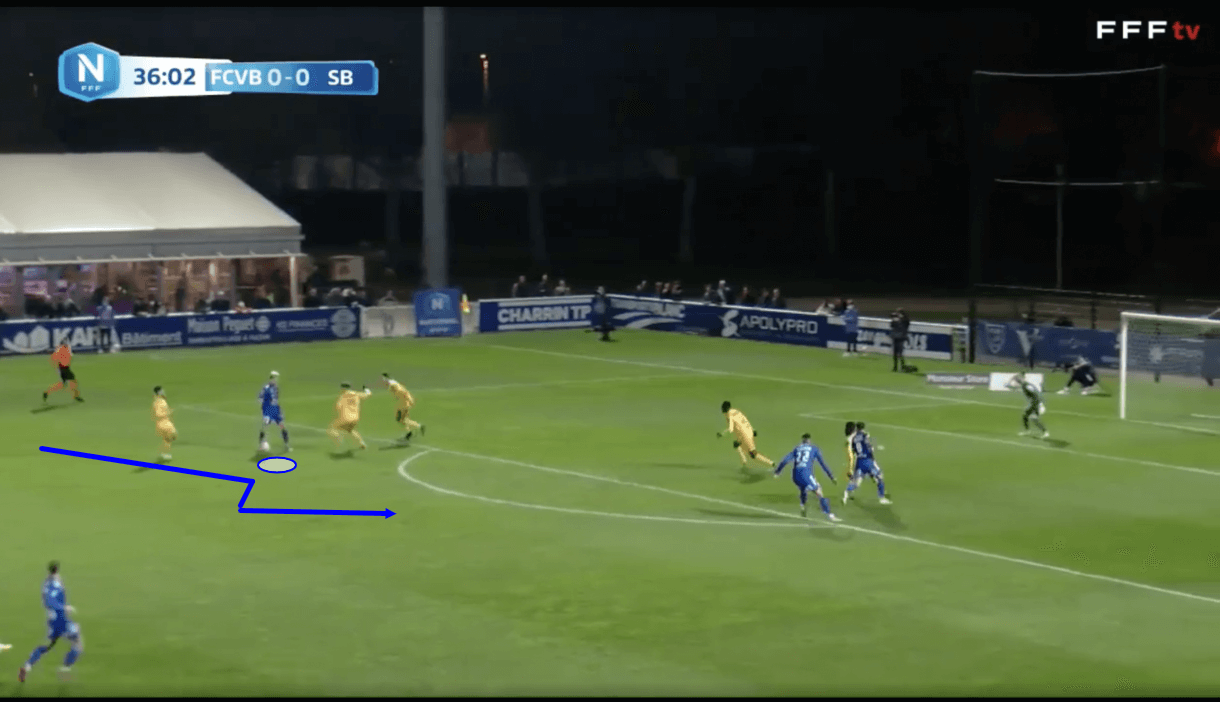
We see an example of an occasion when Da Silva carried the ball into a highly-congested area and managed to escape this area into a freer space closer to goal with the ball fully under his control in figure 8. The midfielder drove into this congested space with the ball from a wider position and ended up as we see him here in the image above, surrounded by three opposition shirts.
Da Silva handled himself well in this situation, knocking the ball with a light touch to the outside while running at pace before continuing to drive forward. This light touch to the outside put him out of the defender’s reach and messed with the defender’s anticipation. This shows an example of how one often just needs a light, subtle touch in these situations, especially with the good level of balance that Da Silva possesses which undoubtedly helps him to pull off manoeuvres like this effectively.
Defensive qualities
Lastly for this tactical analysis and scout report, I’ll spend some time looking at Da Silva’s defensive qualities — an important part of the game for any player in any position in the modern game, especially one situated in the middle of the park. While he can accurately be described as a creative midfielder who’s at his best when his team is on the ball and when he is placed in or around the final third, Da Silva is active in defensive phases, or at least has been thus far in his career, which we’ll highlight via analysis of his performance in defensive phases during his loan spell with Villefranche.
Per Wyscout, Da Silva ranks 28th out of the 97 central midfielders to have played at least 600 minutes this season in National 1 when it comes to successful defensive actions per 90 (10.17). The midfielder ranks 24th out of those 97 midfielders for interceptions per 90 (4.63) and ranks 27th out of those 97 midfielders for defensive duels per 90 (8.52). So, from this information, we can safely say that Da Silva makes a significant contribution without the ball, with work rate not a concern for the 19-year-old.
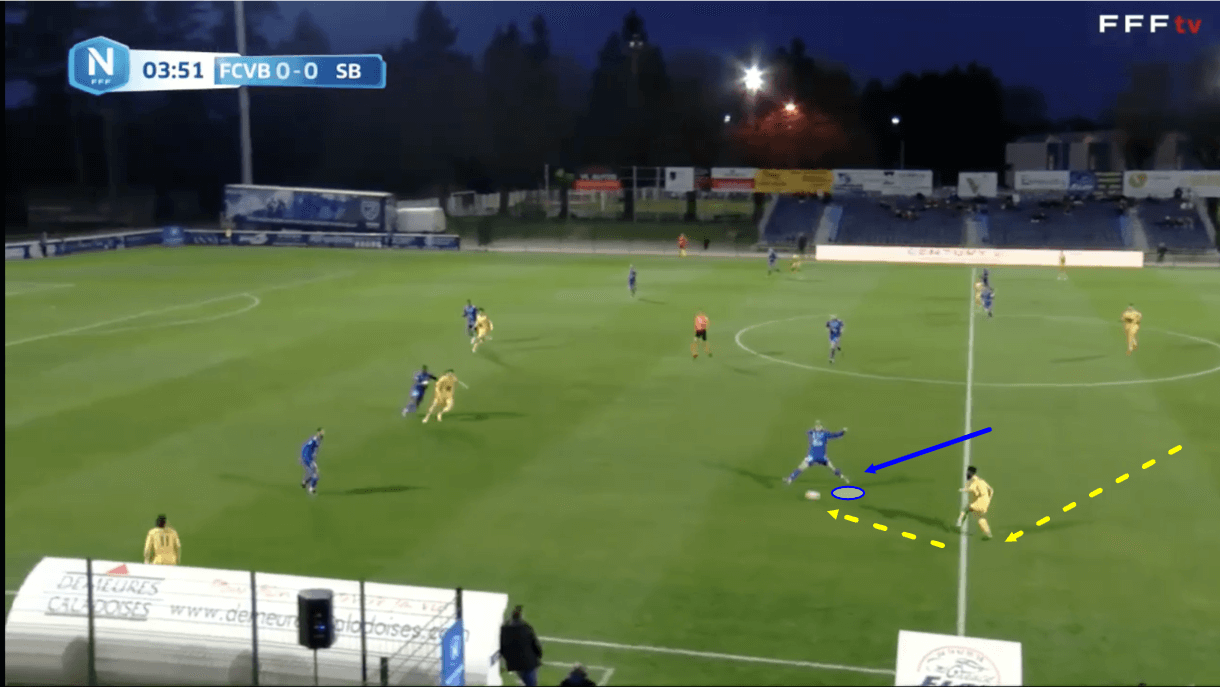
I believe interceptions are the most impressive part of Da Silva’s defensive game, with figure 9 showing an example of the Villefranche loanee making an interception for his side in a recent National 1 game. Just before this image, the opposition passer received the ball from a deeper player and he aimed to relay it forward to a more advanced teammate. However, Da Silva was positioned well to stop this attempted forward pass and managed to cut it out well with his stronger right foot.
The midfielder’s anticipation and spatial awareness were key to pulling this off, as were his technical ability to pull off the interception and reaction speed to get into position in time. However, I’d stress that his anticipation and spatial awareness were more important than speed here, as he had positioned himself well by the time the pass was made to cut it out without needing to cover much more ground. I’d say that these traits are the most prominent traits within this midfielder’s defensive game and they’ve been key in his solid interception numbers at Villefranche this season, along with his enthusiasm to be in position to cut the ball out and regain possession for his side.
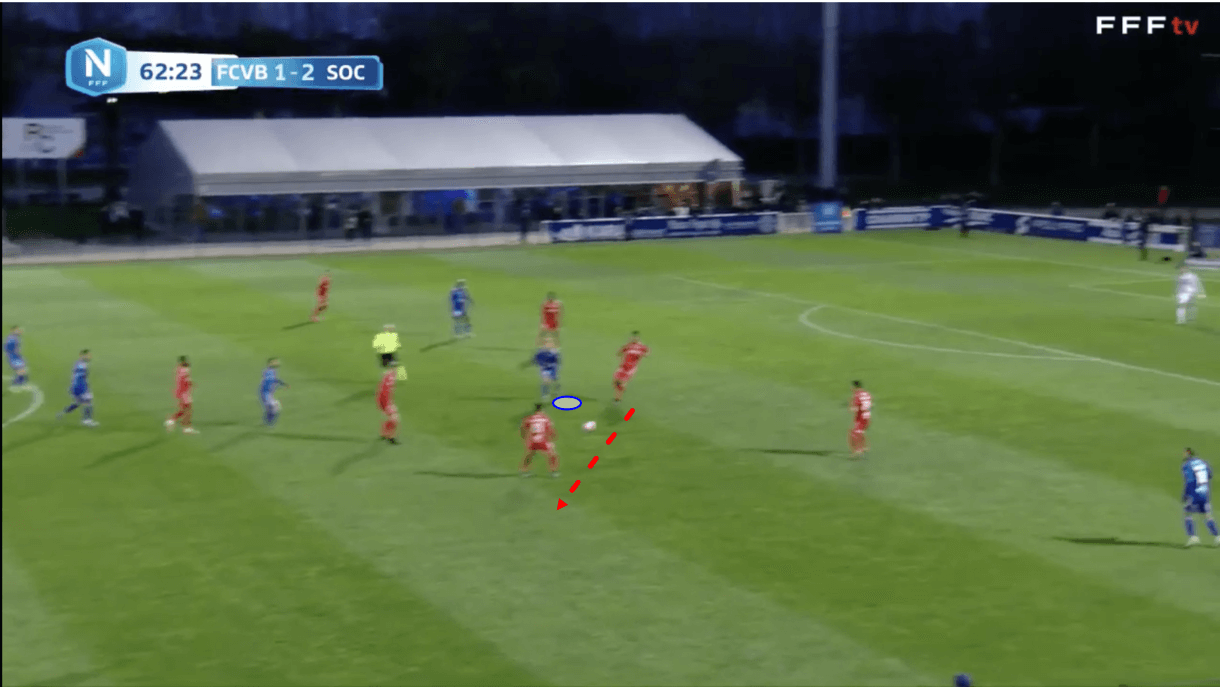
This enthusiasm and positive attitude concerning defensive work is also evident in the passage of play shown in figures 10-11, which shows an example of the midfielder’s willingness to track back and help his deeper teammates out when necessary. Just before figure 10, Da Silva was the target of a forward pass. However, that pass failed to meet the intended target, instead falling into opposition feet, allowing the opposing side a chance to spring a counter.
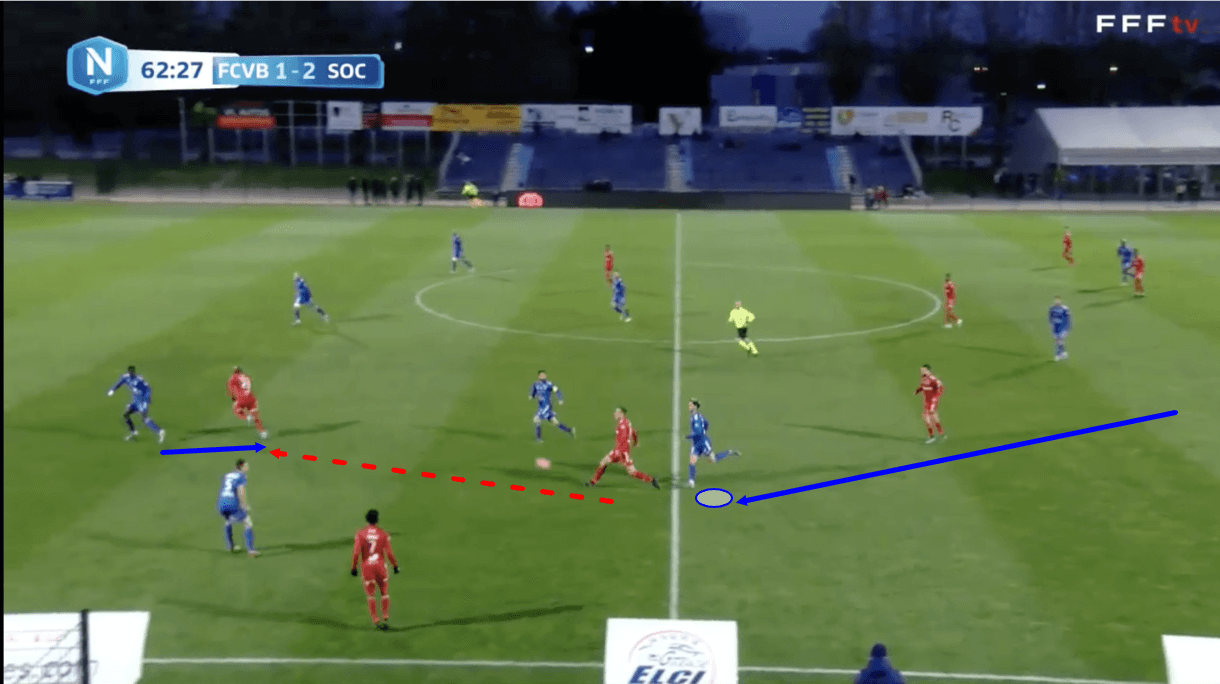
We saw in figure 10 how Da Silva immediately reacted to the turnover positively by springing into action and beginning to track back and we see how this continued as the opposition progressed further upfield in figure 11, in which Da Silva is highlighted on the tail of the opposition ball-carrier as he breaks into Villefranche’s half of the pitch.
Thanks to the pressure the 19-year-old put on the opposition ball-carrier, that player was forced into a rushed decision and a rushed pass which was ultimately intercepted by a Villefranche centre-back. If not for Da Silva’s defensive work rate and pressing intensity here, the opposition player would have had more time on the ball to think through his next move and perhaps slow the play down while waiting for more bodies to get upfield in support. However, Da Silva’s pressure denied the opposition this opportunity and we see the negative results of rushed play in figure 11, as the attempted through pass was intercepted, ending this counter-attack.
Da Silva is far from a perfect defensive force — he is clearly not the biggest or strongest player in the world — but he doesn’t need to be in order to have a positive impact for his team in defensive phases as this section of analysis has shown. That said, while he engages in many defensive duels, he doesn’t have a good defensive duel success rate, which I’d attribute to a combination of lacking physicality and technical defensive quality in terms of tackling. Da Silva is a young player, which makes these minor rather than major problems for now, however. The midfielder could develop his physicality more to improve his on-the-ball and off-the-ball game. I’ll stress that he doesn’t need to bulk up a huge amount but building some more lean muscle won’t hurt him in the long run. Furthermore, I believe that developing the timing of his tackles would also be a major benefit to the midfielder’s defensive game, as he can sometimes mistime tackles, leading to unnecessary fouls being conceded. Overall, however, I’d say the defensive side of the game is a positive part of Da Silva’s profile.
Conclusion
To conclude this scout report, I feel that Da Silva is a really exciting talent, as many have already indicated. I believe his future lies in a more advanced position with a (or two) holding midfielder(s) behind him allowing him the freedom that he enjoys to roam about in the final third, using his ability to find and exploit space to the maximum.
I believe that Da Silva is a great young playmaker and, from what I’ve seen, a solid asset for his team in defensive phases too, so while he may not be 100% ready to star in Ligue 1 just yet, I do feel he should be integrated into Lyon’s first-team setup on returning from this loan spell, as it’s probably the logical next step for the teenager at this stage of his career.





Comments